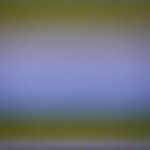Another little lesson in astrophotography, one more in a very lengthy list… Do not use too short an exposure with the flat source.
Flat frames are used to calibrate out any uneven field illumination or dust in the field. This ever more important with the new camera, the larger, full frame sensor shows some vignetting at the corners. I use an electroluminescent source to do my flat frames, actually an old laptop back-light that has been re-housed in an acrylic frame. It provides an even illumination across the aperture of the telescope or lens I am using to acquire the flat field calibration frames.

I discovered the effect as I took flats the first time with the Canon 6D. I had the ISO set to 6400 which resulted in a 1/4000 sec exposure. Fortunately I looked at the last flat and saw the problem before I dismounted the camera from the telescope, it was pretty obvious. Once the optical setup is disturbed it is not possible to re-shoot the calibration frames.

Slowing the camera down removes the effect. As I could not change the aperture I simply reduced the ISO to minimum, this slowed the shutter speed to 1/15 of a second for the nice mid-scale exposure needed for flats.
The corrected flats reveal the usual things that a flat is takes to correct. The dark corners reveal the expected uneven field illumination. the dust doughnut reveals at least one notable speck of dust on the cover glass of the sensor. There is a dark band at the bottom of the frame which I believe to be shadowing from the edge of the mirror. Looking at the flat I realize I will need to be conscientious about taking flats with the Canon 6D.

